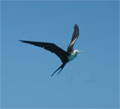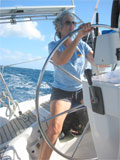 |
| Frigate bird |
Hot air rises. The tropics are hot. The earth spins to the east. Tropical air rises, flows north and is replaced by cooler air flowing south. The resulting northerlies are deflected to the west by the earth's spin. Voila: trade winds. These winds are the balmy 15 knot breezes out of the north east that cut the tropical heat, disperse the tropical insects and draw the tropical tourists.
Most of the winter the winds are much stronger. Much to the dismay of European cruisers who took the long downwind cruise from the Azores with visions of carefree sails in mind, you must watch the weather here. The main complication is the pressure gradient between the central Atlantic and the western Caribbean. High pressure to the North + low pressure off Columbia to the south = "enhanced" trade winds which can howl in the rigging for days. Such winds cause cruisers to clump in protected anchorages waiting for a "weather window" before moving - particularly before moving east or north. These windows usually open under the influence of one of regular procession of fronts moving off the southeastern US. They penetrate the northern Caribbean and stall, blocking the influence of the high or deflecting it north and/or east. For several days, the winds will be moderate, the seas will fairly quickly lie down and the cruiser anchorages empty out.
 |
| S/V Nancy Dawson sailing downwind |
 |
Frigate Island Anchorage
(we are not suffering) |
Charterers and other persons with schedules push on despite the weather. Winds, which might have blown at 25 knots for their entire duration of their short vacation, give us pause but don't phase the newcomer. The fact that they have blown over 800 miles of deep Atlantic waters only to stand up and salute when they reach the shallow Caribbean basin, brings us to a full stop. People who persist in beating to windward in such conditions are considered the local equivalent of the "mad dogs and Englishmen" wandering around in the noon day heat. We spent the strong blow hanging out behind Frigate Rock off Union Island in St. Vincent and the Grenadines. When the lull finally came, our little band of cruisers broke up and we moved down to Carriacou. The lull was already stale when we left Carriacou and the winds and seas were starting to build. No problem, we were headed southwest. We flew down the windward side of Grenada averaging 7 1/2 knots over land sometimes aided by a west setting current. To us, this breakneck speed was quite comfortable. As if to illustrate the saying "Gentleman sail downwind", Susie mixed, kneaded, raised and baked bread while I tended to the fishing line.
click for next column>>
|
 |
|
Examining the rocks at Frigate |
The southern coast of Grenada is punctuated by deep fjord-like narrow bays that penetrate quite a ways inland and are mostly protected by fringing reefs that stop the wave action from penetrating. High winds can still blow overhead but don't come down to spin our wind generator. We entered St. David, the first bay on the southern coast, surfed through the breaks at the entrance and doused sails in the sudden calm and quiet of this long narrow anchorage. St. David is a wonderful hurricane hole. The winds don't penetrate and there is no one around to molest your boat. After hiding out in a very isolated anchorage, we were ready for a little more life. Accordingly, after a very restful night, we set off at a pleasant hour on the short cruise "around the corner" to Clark's Court Bay. The winds were so soft I almost left the dinghy hanging in its overnight position on the davits. Habit kicked in and I lowered it for the slightly more cautious tow just before unfurling the jib for the leasurely one mile reach out past the reef to open water.
 |
|
Susie at the wheel |
 |
Lance at the wheel
(not shot from below) |
Habits are good. There is no way we could have managed to secure the dinghy after we passed the reefs. Huge steep seas built by strong breezes worked against current and we were most suddenly in the Maytag zone. Surfing down breaking wave faces in double digits with the dinghy throwing water up behind, the noise is terrific. It was only another 3 miles to the next bay's entrance so the ride was short. The thrill of sailing in such conditions is much like skiing in moguls on a black diamond run. Big difference: it is not desirable to go head over heels with tons of boat and all your worldly possessions. As we heard one Brit laconically commenting on the VHF "its a bit horrible out here" as he turned back in. The saving grace is at the these speeds the cruise was over before we really could scare ourselves. Just before flying past the entrance to Clark's Court, we jibed and managed to hourglass the jib and jam the furler. The sudden quiet of the inner portions of the bay made it easy to sort out the mess and get anchor down. In here, we've even been reduced to running the engine for power. Out there the winds may still be howling. No wonder many Caribbean cruisers become bay barnacles lying at anchor waiting to register on new charts as a reef. Fortunately for you, loyal reader, we are made of sterner stuff. We also will check the weather next time, even for the shortest little sail.
|